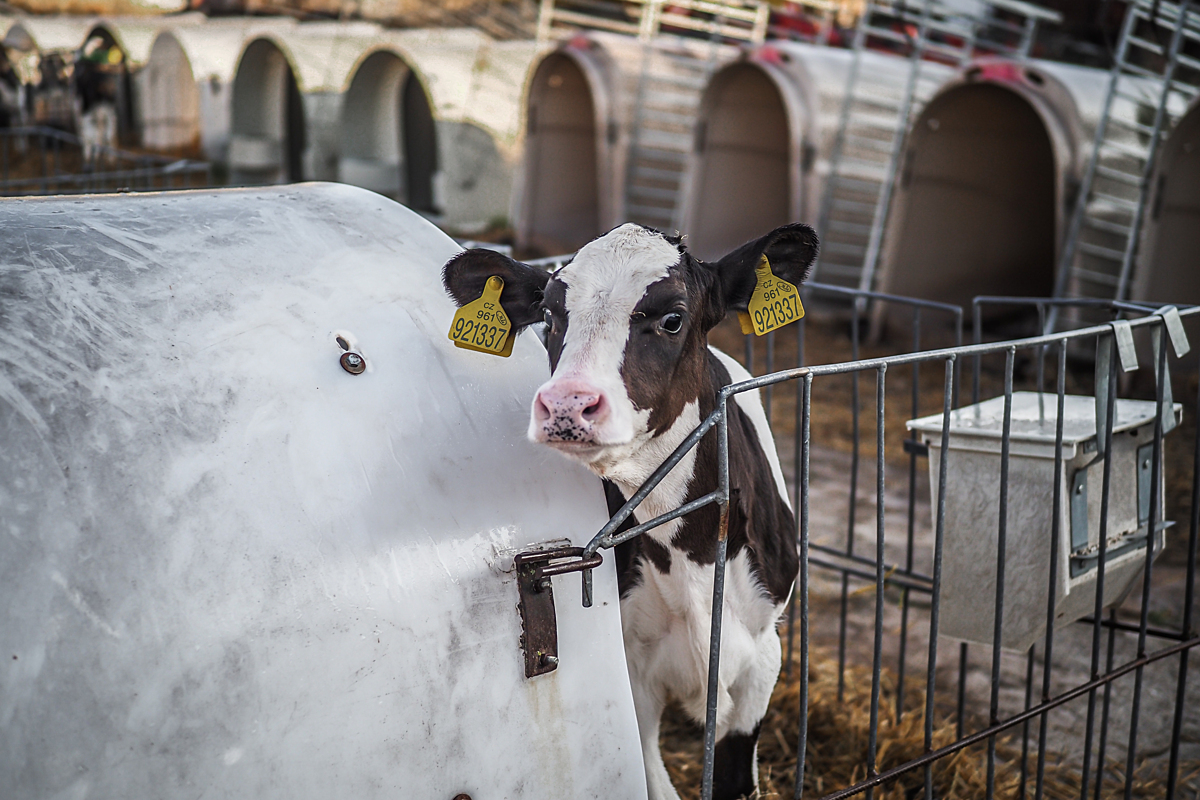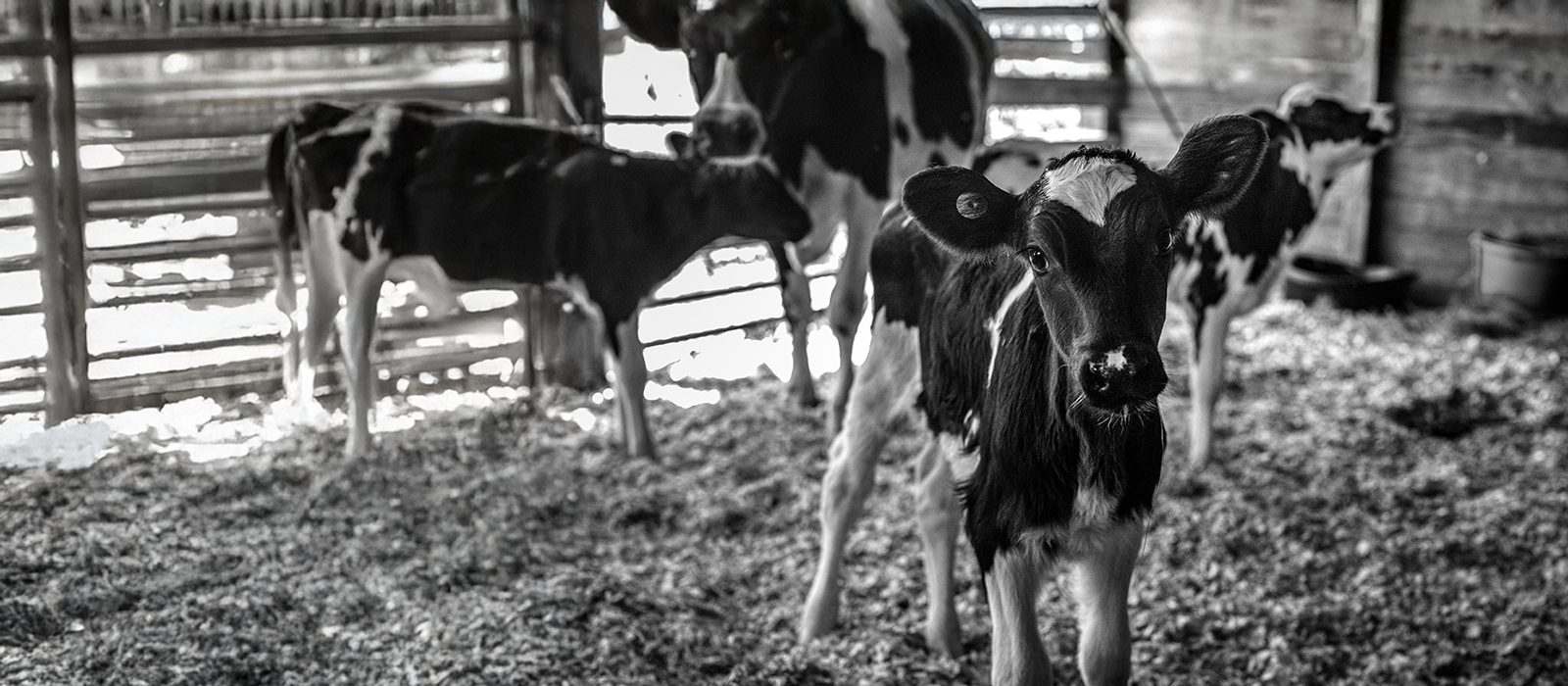In natural conditions, cows live in small, matriarchal groups and form close bonds with each other, using different vocalisations for different family members and even grieving when separated. The farming industry destroys these bonds, forcing cows to live in huge herds and separating mothers from their calves. In the UK, cows are farmed for their milk (dairy) and meat (beef) accounting for almost 10 million individuals.
Farming cows for their milk
Of the 10 million cows confined to farms in the UK, 1.8 million are adult ‘dairy cows’ who endure a near-constant cycle of pregnancy and birth in order to produce milk for human consumption. To meet demand for commercial quantities of milk, cows cannot also feed their babies so the pair are separated typically just 24 hours after birth causing acute stress: they will cry for each other, sometimes for hours, while mothers have been known to break out of fields and walk for miles in search of their calf.
In natural conditions, female calves would suckle from their mother for 9 months and live together for life while male calves would suckle for a year before leaving to join a bachelor herd. Mothers are forced to give birth and endure this loss every single year.
Every year in the UK, tens of thousands of calves are slaughtered so that farmers can sell their mothers’ milk. These are typically the male calves who are ‘useless’ to the dairy industry because they cannot produce milk. Some will be transported to veal farms, fed exclusively on milk and typically housed in isolation to prevent exercise (which darkens the meat), while others will be slaughtered and turned into baby food or cheap meat products like pies. Some male calves are simply shot in the head straight after birth, but numbers are difficult to pinpoint because farmers may shoot them before registering their births.
In natural conditions, a mother cow stores approximately 2 litres of milk in her udders to feed her calf. But on dairy farms, cows are expected to produce unnatural quantities of milk, leaving her to carry as much as 32 litres in her udders at any one time. Producing so much milk takes a huge toll on her health and ability to fight infections or recover from injuries.
On dairy farms, most pregnancies (over 90%) are induced by artificial insemination. This process is intrusive and traumatic for cows, yet inexperienced farmers are allowed to practice the technique on live animals. This is often followed by potential calving difficulties where semen from large bulls is used to produce large calves, which the mother’s bodies cannot cope with. In some cases, permanent nerve damage leaves the cows’ unable to stand and doing the splits. The industry response? To shackle their hind legs together so that cows can continue walking to the milking parlour.
Some dairy herds in the UK will graze outside between April and September, providing the weather allows, but will be confined to sheds for the remaining six months with no access to the outdoors. An increasing number of dairy cows (currently around 20%) are being kept in ‘zero grazing’ systems. This means they are kept permanently indoors, never feeling the grass beneath their hooves, and fed a high-concentrate diet of grains and cereals.
These sheds are typically barren, concrete cubicles that ignore all natural instincts and behaviours, such as playing, grazing, and socialising. Housing cows in close proximity also allows contagious diseases to spread and worsen over time, and frustration behaviours to appear such as aggression and bullying.
The health of dairy cows is pushed well beyond its limits, forced to nurture an unborn calf and give birth while still lactating from a previous pregnancy. This is why many dairy herds have a skeletal appearance with protruding hips and spines, because their bodies are relying on energy reserves just to keep them alive. It’s also why 4-9% of cows suffer from a condition called ‘milk fever’ caused by a sudden depletion of calcium reserves following birth and lactation. Symptoms include muscles tremors and weakness, bloating, constipation, and even coma and death.
Mastitis is an infamous infection of the udder caused by bacteria entering the teat canal. This causes pus to seep into the milk, yet current regulations actually allow milk to contain hundreds of millions of pus cells before it’s considered unfit to sell to the public. This acutely painful condition affects around 60 in every 100 cows.
Conservative estimates say that between 20-40% of British dairy cows are lame at any one time. This is due to several factors including concrete housing, a lack of good quality bedding, and the now near-universal practice of feeding animals wet, fermented grass (known as ‘silage’) rather than dry hay. Silage produces wet, acidic faeces that softens hooves and causes infections. Finally, modern dairy cows have such heavy, distended udders that most simply cannot stand or walk properly.
A cow’s natural lifespan can be as long as 25 years. But on a modern dairy farm, they will be physically exhausted, lame and infertile by just 4-5 years of age. No longer able to produce the quantity of milk demanded of her, she will be sent to slaughter.
Slaughtering cows
Most cows in the UK are slaughtered at around two years old, but there is a spike in slaughters around 15 months likely due to the increase in intensive systems that ‘finish’ animals (fatten them up to slaughter weight) much quicker. Cows over 30 months of age are not allowed to enter the food supply chain due to risk of BSE (known as ‘mad cow disease’) so there is another spike in slaughters around 29 months of age. A cow’s natural lifespan can be 20 years or more.
Cows are most commonly stunned mechanically with a bolt shot into their heads. The percussive impact of the bolt is supposed to cause instant unconsciousness, so that the cow cannot see, hear or feel the next stage: being shackled by their hind legs, suspended from an overhead conveyor belt, and their throat cut. They are then bled to death.
UK law states that all animals must be stunned before slaughter. However, there are exceptions, such as non-stun slaughter for religious purposes, and cases where stunning has not worked, like when cows move their heads and workers ‘miss’ the bolt gun, having to make several, excruciatingly painful attempts to stun them. There is always the risk that animals may regain consciousness too quickly and be awake for the bleeding and butchering.
Prior to stunning, the moments leading up to slaughter are equally troubling. Cows are social, emotionally intelligent animals who are affected by the anxious cries of other cows. The smell of fear and blood often leads to futile attempts to escape.

Take action for cows
Killing an animal can never be considered humane because animals' lives are as important to them as ours are to us. Take action today for a kinder tomorrow.

